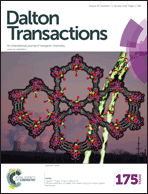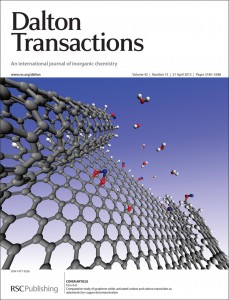The 2015 Journal Citation Reports® have just been released and we are pleased to announce that Dalton Transactions received an Impact Factor* of 4.177.
We would like to thank all our authors, referees and readers who have contributed to this success, as well our Editorial and Advisory Boards for their hard work and continued support. Because of you, Dalton Transactions has continued to move from strength to strength as the largest publisher of high quality fundamental research across the fields of inorganic, organometallic and bioinorganic chemistry.
We invite you to submit your best work to Dalton Transactions!
Also of interest: Find out how other Royal Society of Chemistry journals are ranked in the latest Impact Factor release.
Take a look at a selection of our most highly cited articles listed below:
Perspectives
A golden future in medicinal inorganic chemistry: the promise of anticancer gold organometallic compounds
Benoît Bertrand and Angela Casini
Dalton Trans., 2014, 43, 4209-4219
DOI: 10.1039/C3DT52524D
Luminescent metal–organic frameworks as explosive sensors
Debasis Banerjee, Zhichao Hu and Jing Li
Dalton Trans., 2014, 43, 10668-10685
DOI: 10.1039/C4DT01196A
Communications
Pillar[5]arene-based diglycolamides for highly efficient separation of americium(III) and europium(III)
Lei Wu, Yuyu Fang, Yiming Jia, Yuanyou Yang, Jiali Liao, Ning Liu, Xinshi Yang, Wen Feng, Jialin Ming and Lihua Yuan
Dalton Trans., 2014, 43, 3835-3838
DOI: 10.1039/C3DT53336K
Full papers
Adsorption of divalent metal ions from aqueous solutions using graphene oxide
Rafal Sitko, Edyta Turek, Beata Zawisza, Ewa Malicka, Ewa Talik, Jan Heimann, Anna Gagor, Barbara Feist and Roman Wrzalik
Dalton Trans., 2013, 42, 5682-5689
DOI: 10.1039/C3DT33097D
Towards cancer cell-specific phototoxic organometallic rhenium(I) complexes
Anna Leonidova, Vanessa Pierroz, Riccardo Rubbiani, Jakob Heier, Stefano Ferrari and Gilles Gasser
Dalton Trans., 2014, 43, 4287-4294
DOI: 10.1039/C3DT51817E
*The Impact Factor provides an indication of the average number of citations per paper. Produced annually, Impact Factors are calculated by dividing the number of citations in a year, by the number of citeable articles published in the preceding two years. Data based on the 2015 Journal Citation Reports®, (Thomson Reuters, 2016).














